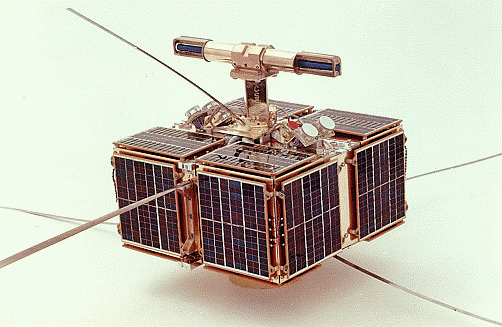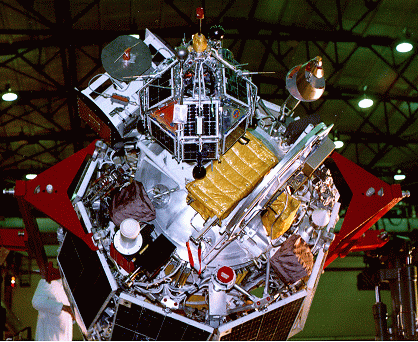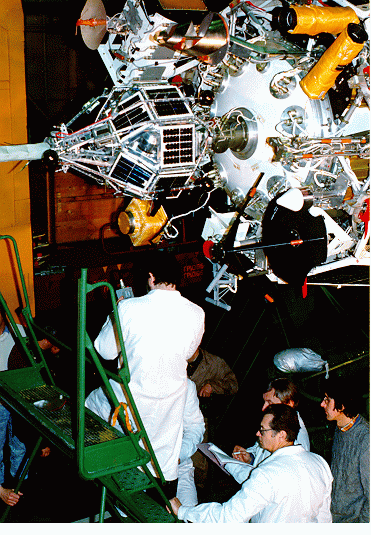Magion History
MAGION is a name of the serial of small MAGnetospheric and IONospheric satellites manufactured
in Czech Republic to be launched as Russian scientific S/C
hitch-hikers. These satellites are designed to perform measurements
of space plasma parameters by a satellite/subsatellite pair
simultaneously in two points which are not far from each other. These
satellites are also intended to perform diagnostic researches in the
region of actively injecting complex mounted on the main S/C.
The history of the MAGION satellites development spings to the
middle of seventieth, when in the frame of the INTERCOSMOS space
programme there were started the development of the first MAGION S/C,
which was launched into the orbit in the pair with the S/C
INTERCOSMOS-18 in 1978.
| Spacecraft | Launch date | Weight | Perigee | Apogee | Stabilization |
| Magion 1 | 24.10.1978 | 15 kg | 406 km | 768 km | magnetic field |
| Magion 2 | 28.09.1989 | 52 kg | 500 km | 2500 km | magnetic field |
| Magion 3 | 18.12.1991 | 52 kg | 438 km | 3070 km | magnetic field |
| Magion 4 | 03.08.1995 | 59 kg | 1 000 km * | 198 000 km * | spin |
| Magion 5 | 11.07.1996 | 64 kg | 1 000 km * | 20 000 km * | spin |
* - initial
1. Magion 1
2. Magion 2
3. Magion 3
 MAGION-1 was launched as a part of the Interkosmos-18 experiment
and separated from this parent spacecraft on November 14, 1978, with
the aim of studying the spatial structure of ELF-VLF phenomena using
simultaneous measurements of the two near-spaced satellites. The
MAGION-1 experiment went on for almost three years, till the decay
date of September 10, 1981.
MAGION-1 was launched as a part of the Interkosmos-18 experiment
and separated from this parent spacecraft on November 14, 1978, with
the aim of studying the spatial structure of ELF-VLF phenomena using
simultaneous measurements of the two near-spaced satellites. The
MAGION-1 experiment went on for almost three years, till the decay
date of September 10, 1981.
Both the satellite and subsatellite were launched into orbit by a
single vehicle. The separation and activation of MAGION-1 were
executed after Interkosmos 18 had been in orbit for three weeks when
all the satellite systems had been tested and switched on as part of
routine operations. A remote - control (telecommand) spring mechanism
imparted an initial relative velocity of 0.2 m/s to MAGION-1 in the
direction of the orbital velocity vector. This meant that the
satellite and subsatellite drew away from each other at a rate of
approximately 60 km per day.
Initial orbital elements: perigee 406km, apogee 764km, inclination
82.96deg., period 96.4min.
MAGION-1 subsatellite had the hape of a prizm with dimentions of
300x300x160mm, from which the individual sensors are aerials
protruded. The surface finish of the satellite body was designed with
regurd to passive temperature control. The weight of the subsatellite
without the separation mechanism was 15kg.
MAGION-1 was equipped with the following main systems:
- 137MHz telemetry (0.25W) and 400MHz telemetry (1.5W);
- telecommand link (24 independent commands, 149MHz band);
- power system consisting of solar panels (2.4W), NI-Cd chemical
batteries (2x4Ah) and a common DC-DC converter;
- magnetic field stabilization;
- a housekeeping system (for checking voltage, currents,
temperature and for switching of the individual regimes).
Experiments:
- electric and magnetic fields from 0.05 to 16 kHz (broadband);
- narrowband channels (0.45, 0.8, 1.95, 4.65 and 15kHz);
- 16-channel frequency analyzer (0.185-15kHz, 60dB);
- resonance exciter (0.8 - 8kHz sweep);
- electric field 0.01 - 80 Hz;
- Geiger-Mueller tubes (electrons above 30 keV) in two directions,
parallel and perpendicular to the magnetic orientation axis.
Project scientist of the MAGIC project I.A.Julin
Institute for Terrestrial Magnetism, Ionosphere and Radioware Propagation, Russian Acad. Sci., Moscow, Russia.
Technical manager of the MAGIC project E.M.Vasilyev vasilyev@mx.iki.rssi.ru
Space Research Institute, Russian Acad. Sci., Moscow, Russia.
Subsatellite project scientist from Czechoslovakia P.Triska ptr@ufa.cas.cz
Subsatellite technical manager from Czechoslovakia J.Vojta jvo@ufa.cas.cz
Institute of Atmospheric Physics, Czech Acad. Sci.,
Prague, Czech Republic.
 MAGION-2 S/C was manufactured as the subsatellite of the ACTIVE
S/C (INTERCOSMOS-24) and as the first subsatellite of a series of in-
ternational scientific projects ACTIVE, APEX, INTERBALL.
MAGION-2 S/C was manufactured as the subsatellite of the ACTIVE
S/C (INTERCOSMOS-24) and as the first subsatellite of a series of in-
ternational scientific projects ACTIVE, APEX, INTERBALL.
As opposed
to the MAGION-1 this S/C series with weight up to 65 kg has the form
of a symmetrical polyhedron, has a set of folding booms for sensors ,
has digital system of data collection and has a gasjet propulsion engine. The scientific goal of the subsatellite of the ACTIVE project
was to investigate space structure of physical phenomena which accom-
pany plasma injection and to investigate powerful ULF emission into
the magnetosphere as in a near (up to 10 km) zone , as well as in
middle and far zones of the main S/C on which active injecting devices
were mounted.
Key ACTIVE mission data
Launch date September 28, 1989
Separation date October 2, 1989
Orbits: apogee 2500km
perigee 500km
inclination 83deg.
MAGION-2 scientific payload:
- magnetic fields, 3 components - magnetometer SGR-7;
- magnetic field fluctuation measurements, 1 component -
magnetometer SGR-6;
- wave measurements: 3 components of electric fields, 1 component
of magnetic fields and spectrum analyzer - KEM-1 wave complex;
- measurements of the temperature and density of cold plasma -
KM-12 and KR-12 instruments;
- Langmuir probe - ZL-A-C;
- radio spectrometer - PRC-2-C;
- measurement of particles - DANI-C, MPC, DOK-A-S, SEA instruments.
Project scientist of the Active project B.I.Shevchenko
Technical manager of the Active project E.M.Vasilyev vasilyev@mx.iki.rssi.ru
Subsatellite technical manager from USSR A.A.Martinson
Space Research Institute, Russian Acad. Sci., Moscow, Russia.
Subsatellite project scientist from Czechoslovakia P.Triska ptr@ufa.cas.cz
Subsatellite technical manager from Czechoslovakia J.Vojta jvo@ufa.cas.cz
Institute of Atmospheric Physics, Czech Acad. Sci.,
Prague, Czech Republic.
 MAGION-3 S/C was manufactured as the subsatellite of the APEX S/C.
The APEX project had the following primary objectives:
MAGION-3 S/C was manufactured as the subsatellite of the APEX S/C.
The APEX project had the following primary objectives:
- Simulation and initiation of aurora and radio frequency
radiation in the auroral area.
- Study of the dinamics of modulated beams and plasmoids in the
near - earth plasma.
- Study of the nature of electrodinamic relationship of
electromagnetic waves in magnetosphere and ionosphere.
- Determination of radio emission characteristics of modulated
beams of charged particles and plasmoids.
- Search for non-linear wave structures of the electromagnetic
soliton type in disturbed environment.
MAGION-3 scientific payload was almost the same as for MAGION-2.
Key APEX mission data
Launch date December 18, 1991
Separation date December 28, 1991
Orbits: apogee 3000km
perigee 400km
inclination 83deg.
Project scientist of the APEX project V.N.Oraevsky
Institute for Terrestrial Magnetism, Ionosphere and Radioware Propagation, Russian Acad. Sci., Moscow, Russia.
Technical manager of the APEX project V.S.Dokukin
Institute for Terrestrial Magnetism, Ionosphere and Radioware Propagation, Russian Acad. Sci., Moscow, Russia.
Subsatellite project scientist from Czech Republic P.Triska ptr@ufa.cas.cz
Subsatellite technical manager from Czech Republic J.Vojta jvo@ufa.cas.cz
Institute of Atmospheric Physics, Czech Acad. Sci.,
Prague, Czech Republic.
Subsatellite technical consultant from Russia Yu.N. Agafonov yagafonov@romance.iki.rssi.ru
Space Research Institute, Russian Acad. Sci., Moscow, Russia.
MAGION-4 and MAGION-5 spacecraft were designed as part of INTERBALL
project. MAGION-4 was launched together with Tail Probe main spacecraft
in August 02, 1995.
Some other pictures
 Back to the Magion Spacecraft Home Page
Back to the Magion Spacecraft Home Page
 MAGION-3 S/C was manufactured as the subsatellite of the APEX S/C.
The APEX project had the following primary objectives:
MAGION-3 S/C was manufactured as the subsatellite of the APEX S/C.
The APEX project had the following primary objectives:
 Back to the Magion Spacecraft Home Page
Back to the Magion Spacecraft Home Page
 MAGION-1 was launched as a part of the Interkosmos-18 experiment
and separated from this parent spacecraft on November 14, 1978, with
the aim of studying the spatial structure of ELF-VLF phenomena using
simultaneous measurements of the two near-spaced satellites. The
MAGION-1 experiment went on for almost three years, till the decay
date of September 10, 1981.
MAGION-1 was launched as a part of the Interkosmos-18 experiment
and separated from this parent spacecraft on November 14, 1978, with
the aim of studying the spatial structure of ELF-VLF phenomena using
simultaneous measurements of the two near-spaced satellites. The
MAGION-1 experiment went on for almost three years, till the decay
date of September 10, 1981. MAGION-2 S/C was manufactured as the subsatellite of the ACTIVE
S/C (INTERCOSMOS-24) and as the first subsatellite of a series of in-
ternational scientific projects ACTIVE, APEX, INTERBALL.
MAGION-2 S/C was manufactured as the subsatellite of the ACTIVE
S/C (INTERCOSMOS-24) and as the first subsatellite of a series of in-
ternational scientific projects ACTIVE, APEX, INTERBALL.